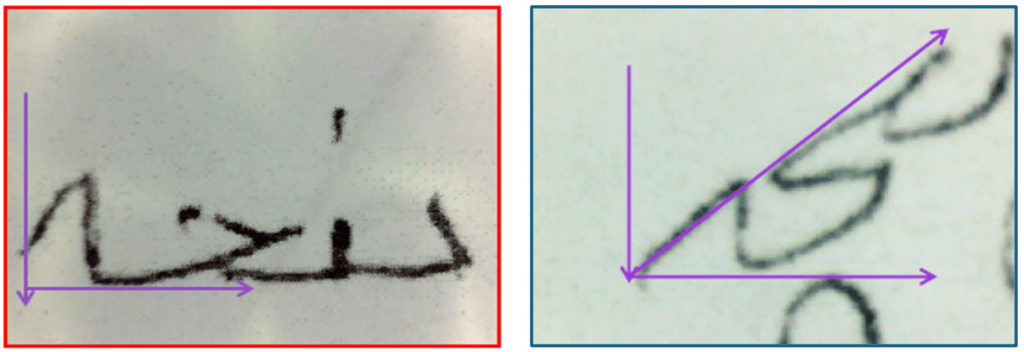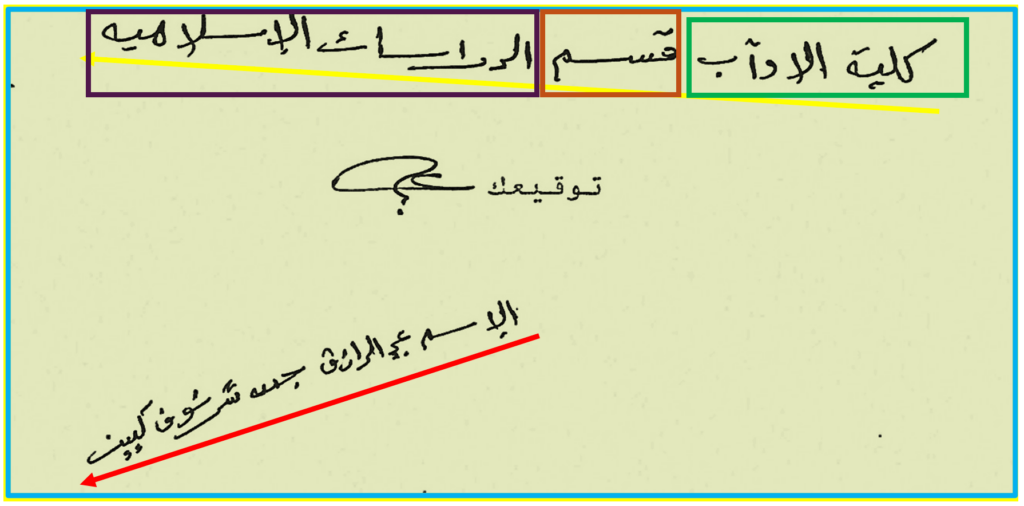THE DIRECTION IN WRITING IN THE ALIFATE OR ARABIC ALPHABET AND HOW TO ANALYZE IT FROM HANDWRITING EXPERTISE AND GRAPHOLOGY
In this post I want to analyze the direction in writing in the aliphate or Arabic alphabet and to do so I must talk about the characteristics of writing in said alphabet.
Direction in writing: “is the direction or direction in which the characters that are part of a text in a given writing system are written and read.”
The oldest linear direction of writing was from right to left because it was conditioned by the support on which it was written, such as the stone and the tool (chisel), which was the most natural way to write; With the right hand one struck and with the left one held the chisel (chisels are hand tools designed to cut, groove or grind cold material, by transmitting an impact. They are usually made of steel, in the form of bars, of cross section rectangular, hexagonal, square or round, with a sharp edge at one end and a bevel at the opposite end).
Other later writings, such as the Greek one in which writing was done with ink, chose the direction from left to right to carry out this type of writing.
Horizontal and vertical writing are those that are typified, but in writing and more specifically in certain calligraphies of writing that uses the aliphate as a code; The direction can be diagonal and even vertical, and mixed, that is, the writing direction varies in the same writing.
Among the types of writing that are written and read in blocks or columns from top to bottom and from right to left, they occur in Chinese, Japanese and Korean, although they currently mix the form of writing with the Western one, that is, they continue writing in columns. from top to bottom, but from left to right.
In this post we focus on the writings that are made in the aliphate or Arabic alphabet and that we can find today.
As I have already written on my blog about the different calligraphic types, I leave the link for consultation of my last presentation on the subject since it would take me the entire post to try to present it here https://cigpericial.es/blog.
In this post we focus on the writings that are made in the aliphate or Arabic alphabet and that we can find today.
As I have already written on my blog about the different calligraphic types, I leave the link for consultation of my last presentation on the subject since it would take me the entire post to try to present it here https://cigpericial.es/blog.
Writing in the Arabic alphabet is conditioned to the type of calligraphy used by the amanuensis. And within the calligraphic types that currently occur in writing, because of their own evolution and development, they have been mixing, since their beginnings they have intermingled and mixed types of them have appeared.
We must keep in mind that the Arabic language in Muslim culture was acquired thanks to the expansion of the Muslim empire and the oral transmission of the language since the compilation of the Quran, which is written in Arabic to date.
Currently, Arabic calligraphy has been declared Intangible Heritage of Humanity by UNESCO in 2021.
The Quran is written using the aliphate and in classical Arabic. The Arabic language is divided into: Classical Arabic; Literary or modern Arabic “fusha”. And finally the dialectal or colloquial Arabic” ̔ ͞amiyya“. Diglossia[1].
With the premise of expanding the Muslim religion and making the book of the Koran known, the language and specifically the writing, it is given the characteristic of a sacred language. And due to the prohibition of the representation of images, calligraphy developed as a plastic art that appears in all the constructions made by them throughout the conquered territory.
Calligraphy written in the Arabic alphabet differs from Western calligraphy in two different ways:
1st.- It had its origin not as a utilitarian means (oral culture), but as a sacred means of communication between God and men.
2nd. – Due to their composition: both are alphabetical, while the letters in the Latin alphabet always constitute separate units, in the Arabic they are part of a unit; all letters join with the next one except for the letters that precede the following letters: و,۱رزدذ
Arabic calligraphy occurs in the westernmost area or Maghreb, with Córdoba, Kairouan, Fes and Timbuktu as the main cities of influence, where Western styles occur. Taking as inspiration the first Kufic writings of the Rašidün period (622-660), at the beginning of the Umayyad period (660-750). At that time, the Maghreb, Andalusian, Sudanese, Kairouaní, and Fasi styles stood out. Currently, what predominates is the use of the Maghrebi-Andalusian style and its variants (mabsut, tulut, maŷuhir, musnad).
In the central area or Šarq al-awsa†, there are three zones of influence in the Arabian Peninsula, the cities of Kufa, Medina and Mecca and on the other hand, the area of the Šam and the Fertile Crescent with the cities of Damascus and Baghdad where it goes. to establish the main traditional styles of calligraphy, the so-called aqlam as-sitta, organized in pairs: nasj/tult; rayhaniı/muhaqqaq; tawqı’/ruq’a mainly under the period of ‘Abbasid government (750-1258) in which the standardization of these styles occurred, with Ibn Muqla (940), Ibn al-Bawwab (1022), Yaqüt al-Musta‘simi (1298) as the main calligraphers.
The third moment of influence occurs with the Ottoman Empire (1299-1923) and especially in the city of Istanbul, al-aqlam as-sitta of Ibn Muqla was developed, also creating and developing the ruqa‘a y diwani / diwani / yalı styles, standing out as calligraphers such as Hamdullah Al-Amasi (1520) among others.
And in the easternmost area there is a combination of calligraphic styles in the countries of Iran, Afghanistan, India and China with their main cities of Isfahan, Kabul, Karachi and Urumqi.
The different governments of such an extensive geography can be distant or closer and related to certain styles: In the time of Rašidün (622-660): predominance of Kufic writings; Umayyad (660-750): development of Maghreb-Andalusian writings; ‘In the `Abbasi (750-1258): developments of the central scriptures, in particular the standardization of aqlam al-sitta styles; ‘Uzmanı (1299- 1923): development of the dıwani/ dıwani yali and ruqa‘a styles. with strong influence of intermediate styles (aqlam al-sitta); the set of independent Asian governments since 660, whose advances in the case of eastern geographies were associated with calligraphic styles (ta‘alıq/nasta‘aliq, šikaste, bihari, sini).
The direction in writing in the Arabic alphabet is marked by the type or types of calligraphy used, and although this type of writing adheres to its general characteristics, there are individual traits specific to the individual who performs it for the same reasons as it occurs with writing in other alphabets, being a major premise in the acquisition and learning of writing by human beings. Size and direction can be considered identifying writing features and in this type of writing the professional must pay special attention.
We are going to visualize certain examples that I have extracted from handwritten texts. For example: in this sentence you can see the oscillation in the writing direction if we analyze the strokes of the Arabic characters.

The calligraphic style in which we could inscribe this writing is Ruq`a, due to the syncretism in the creation of the graphemes and diacritics, and in the direction of these, because this calligraphic style was created based on the scriptural support and this style. which means “piece”, it is used to be able to write on a support that is small and soft like paper.

If we observe the body of writing individualized by words, we can see the geometric bodies that form in the same sentence, the oscillation in direction makes it an important factor in the identification of writings in expert analysis.

If we look at these images of the same word, it is as if the image on the right was written in a mirror, with the diagonal being its direction of execution, while in the image on the left it maintains horizontality in the execution of the characters.

If we look at these images of the same word, it is as if the image on the right was written in a mirror, with the diagonal being its direction of execution, while in the image on the left it maintains horizontality in the execution of the characters.

And finally, we are going to analyze the direction in this type of calligraphy, which is a continuous writing, that is, there is no separation of words.
This calligraphic style is called Nastaliq, the union of the Nash style and the Taliq, which tends in some of its beginnings on the diagonal like the Ruq’a, however it maintains horizontality in the body of the word, The Nas-Taliq is a light and elegant cursive writing unlike other Islamic scripts, the Nas-Taliq has characters that seem to oscillate from the top right to the bottom left of each word as if they were suspended by an imaginary line.
With these examples I hope you have been able to see the complexity of handwriting in Arabic characters, due in part to the great development and expansion of different calligraphic styles that make it difficult to identify characters for later comparison with other writings in the same alphabet.
I hope that this post has been useful to you to continue studying this subspecialty that is so complex, but at the same time so unknown in criminology in Spain.
[1] Diglossia: A situation in which there are two different forms of the same language used by a community, used in different social situations








